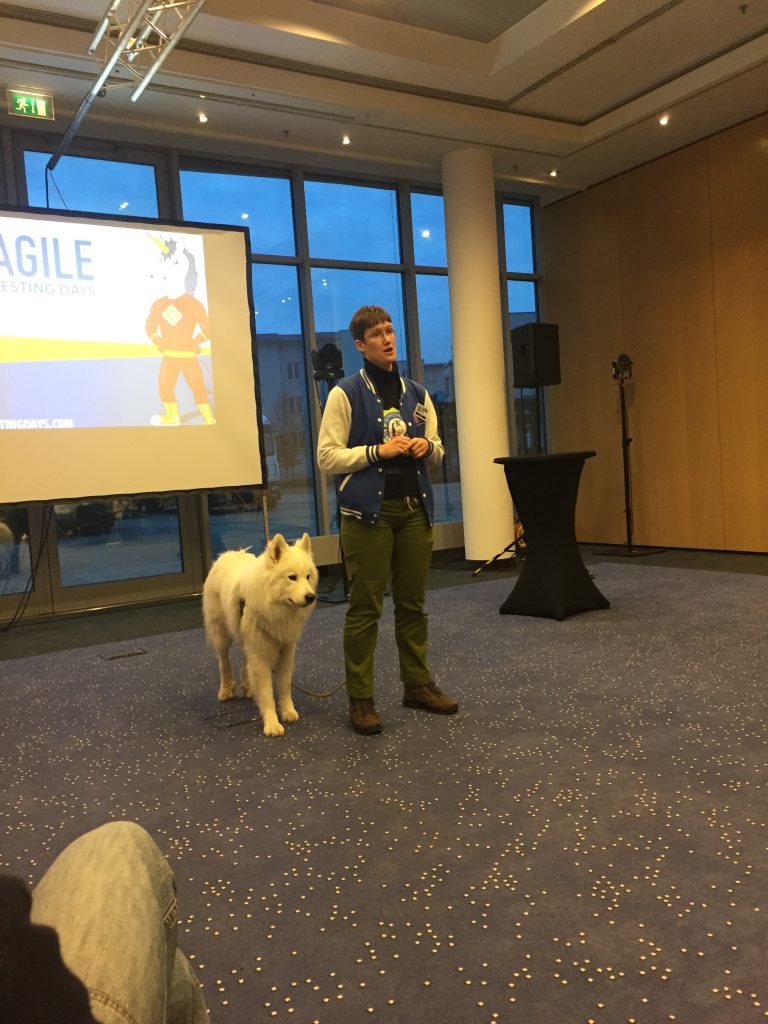Agile Testing Days 2016, Day 2
In the morning I was having the all too familiar fight with nerves again (every time I am about to give a presentation this happens). I stayed sober the night before, but I had very little sleep. I was already ‘busy’ with my talk in my mind. At breakfast, I struggled with a small egg sandwich again and I just went upstairs and practiced a little. So, no keynotes and other talks for me yet, I wouldn’t hear a thing anyway.
The talk itself went quite alright. I had some technical difficulties. Payed 80 bucks for PollEverywhere and it didn’t even work on dual screen. Yeah, I’m gonna try and get my $$ back. Also, I had tested it on my room and apparently, my session wasn’t closed so the audience saw the last question somehow? It was pretty weird.
Anyway, after the rough start the rest of the talk went smoothly. I had fun and I hope people went away with a little more knowledge and a lot more inspiration. I feel very relaxed now and I’m going to drink a few beers with some people tonight. Cheers, already!
All the information from my talk and resources can be found in Google Drive
During the lunch break we played Eddy’s game Gameception. It’s a really fun game that he designed himself. I’m looking forward to the gaming tonight!
Keynote Huib and Alex – Once upon a time…stories that make you awesome!
What is storytelling and why is it something you want to get better at?
What separates human beings from other animals? The use of words. We can tell stories that can mesmerize others, that can set in motion great things (and terrifying things).
What testers usually do, is they write bug reports in a very boring manner, “we found six bugs, we executed 400 test cases, etc”. Why not tell a story about how and what you’ve tested?
A story has to stand on its own, has a beginning a middle and an end. People like struggle and fights, so that’s why we have fairytales. A story makes you feel something. A story is always personal.
The simple structure is Freytag’s Pyramid.
- Exposition
- Rising action
- Climax
- Falling action
- Resolution
Almost any story follows this structure more or less.
Why does it matter anyway? Because it will make other people understand you better, your emotions. They can inspire and motivate others. That way you can have influence people. And also, they help you remember stuff better.
The science behind it. Stories can provide our brain with:
- Cohesion
- Meaning
- Purpose and motive
- Fill in the gaps
- Human Perspective
- Conflict
- Rely on limited information
The testing story
This is a story about the status of the product, about how you tested it and about the value of the testing you did. Instead of giving a boring bug report, you can use a Product Coverage Outline, which is more inviting to tell a story about. Alex says that she changed her story refinement meetings. She focusses on explaining the WHY of user stories to everybody in the team, so they can empathize with the user. Her team is not looking at JIRA anymore during refinement meetings and it helped.
There are other stories in your work. During demo and sprint reviews, we use personas, we talk about risks etc.
Then they had us practice with telling stories to the person sitting next to you. I had the honor to be sitting next to my name-buddy Meike, so we told each other about our passion. The whole room was filled with buzz and noise so it seems like everybody got into the groove of telling a story!
Alex ended this keynote with a personal story of how she started violin playing and what her violin means to her. I saw more than one person wiping away a tear or two. I think I know her better now, as does the rest of the audience!! The best way to end a keynote, now it is 100% sure everybody will remember it.
After this keynote I went to the consensus talks.
Roy Mohamed – 4 BOXES: HOW TECHNO TAUGHT ME TIME MANAGEMENT
Roy told me that if I didn’t show up for his talk he would, and I quote, “personally kick my ass”. Well, what choice did I have. It ended up being well worth my time.
Roy, whom I’ve met at the Speakers Dinner, is a techno lover. And somehow, magically, he thinks about the Eisenhower Decision Matrix during raves. Don’t ask me why or how he does that. I suspect he is not entirely sober at that time.
He uses the Eisenhower Decision Matrix at home on his giant glass Scrum wall. He draws it on there and it helps him to keep focus and prioritize his tasks (that are not work related). Every two weeks he finishes his sprint and starts a new one. He is a Scrum master, after all.
Even more shockingly, he uses estimates! He’s a brave soul. He uses estimates, because it is only for personal use, and he knows himself quite well after working with his system for almost two years.
Btw, he had to wing his talk completely without slides and drawing things on the white board because there are technical difficulties in the room with the beamer. Great talk, all in all!
During the break I notice myself getting in a sort of hyper state. And that is without any beer at all! It’s going to be a great evening. I went to the lightning talks again, because I like the format.
Meike Mertsch – White Dog Black Dog
She actually brought her beautiful dog: Hagrid. She opens up with her personal story about depression (the black dog). She has been diagnosed with depression years ago and she tells about how it has affected her life so far: sleep problems, it follows you around and lashes out when you least expect it, feeling angry and all that.
I find it very brave that she opens up about this and it says something about the safe space this conference is. Her boss is very helpful towards her: he takes her apart when a big change is coming up and asks her how she is feeling about this. To any ‘boss’ who reads this: this is awesome!! Her boss is helping her to avoid having ‘the black dog’ following her around.
In the end she did try anti depression meds, while she was against them before. A talk with Gitte helped. Taking the meds can get you to a point where you can go further. It’s just a stepping stone, a starting point to get better.
She ends up with telling people to always try to find ‘the white dog’ in yourself: know what makes you happier, know what triggers you, seek out things that make you feel better.
The rest of the day
I didn’t feel like blogging anymore for the rest of the day and just enjoyed the aftermath. After the last keynote I went to the beer tasting and testing session by Eddy and Bram. The first 5 beers were really nice, but then we got beer with bugs….Ugh, we tasted one that was like sewer. And what do you know, the guy from London liked it! Must have tasted like the Thames or something. I skipped most of the cabaret because of how hot it was in the Fritze pub. Felt like sipping some beer more. At about 2:30 I called it a night!




Comments ()